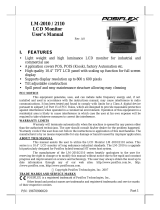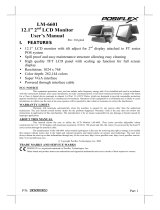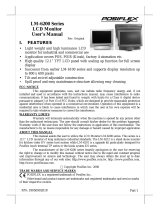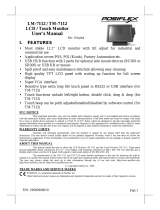Page is loading ...

Package Contents
LM-8015E
15” LM-8015E Monitor…………...(x 1)
Extension Pipe…………………….(x 1)
VGA Cable………………………..(x 1)
Mounting Kits…………………......(x 1)
User Manual……………………….(x 1)
LM-8025E
15” LM-8025E Monitor…………...(x 1)
Extension Pipe…………………….(x 1)
VGA Cable………………………..(x 1)
USB Cable………………….……..(x 1)
Mounting Kits…………………......(x 1)
User Manual……………………….(x 1)
LM-8035E
15” LM-8035E Monitor……....…..(x 1)
Connecting Bracket for
15”/17” KS-series Terminals ..........(x 1)
VGA Cable………………………..(x 1)
Mounting Kits…………………......(x 1)
User Manual……………………….(x 1)
LM-8045E
15” LM-8045E Monitor……....…..(x 1)
Connecting Bracket for Gen 5 Base
…………………………...…....…..(x 1)
VGA Cable………………………..(x 1)
Mounting Kits…………………......(x 1)
User Manual……………………….(x 1)
LM-8055E
15” LM-8055E Monitor……....…..(x 1)
Base Bracket for Gen 6 Base……..(x 1)
VGA Cable………………………..(x 1)
Mounting Kits…………………......(x 1)
User Manual……………………….(x 1)
19630901020 Ver. A0
http://www.posiflex.com
LM-80X5E
POS Monitor User Manual
1

Views of LM-8015E/8025E
Front View
Views of LM-8035E
Front View
LED Indicator
15” LM-8015E LCD Panel
LED Indicator
15” LM-8035E
LCD Panel
15” LM-8025E LCD Panel
SD-466Z
Side attachment
with MSR
(Optional)
2

Rear View
Views of the LM-8045E
Front View
Rear View
Mounting Bracket
LED Indicator
15” LM-8045E
LCD Panel
Mounting Bracket
for Gen 5 Base
Connecting Bracket
3

Views of LM-8055E
Front View
Rear View
LED Indicator
15” LM-8055E
LCD Panel
Mounting Bracket
Base Bracket for Gen 6 Base
4

Right-Side View of LM-80X5E
I/O Ports of LM-8015E/8035E/8045E/8055E
I/O Ports of LM-8025E
VGA Port
DC-IN Power Jack
OSD button
EXT button
+ button
- button
OSD Control
B
Power button
VGA Port
USB (Type B) Port
DC-IN Power Jack
USB (Type A)
5

Mounting LM-8015E/8025E to Gen5 Base
1. Lay LM-8015E/8025E on a flat surface.
2. Securely support the extension pipe to aim
the screw holes of the mounting fixture at the
hole pattern on the rear of the LCD panel.
Then, fasten the mounting fixture using four
screws.
3. Take VGA cable. Neatly thread the cable from the bottom of the
extension pipe and pull them out of the cable exit. Connect VGA cable
to the VGA port of LM-8015E/8025E.
4. Press down the release button on the rear side
of Gen 5 base and then remove the cover in
the direction as shown in the figure.
5. Holding your pipe, attach the two screw holes, located at the base of the
pipe, to the screw holes of Gen5 base as shown in the below figures.
Then, insert two screws and fasten them to fix the pipe to the base.
Cable Exit
6

6. The installation is completed.
Mounting LM-8035E to 15”/17” series Terminals
KS-7215 with Gen 8.5 base will be used to demonstrate installation of
LM-8035E in the following example.
1. Position your terminal with its rear facing
towards you.
2. Take L type mounting bracket out of LM-
8035E box package. Align the four screw
holes of the mounting bracket with the hole
pattern at the back of the terminal, insert four
#6-32-12L fixing screws into the screw holes
and then tighten the screws to secure the
mounting bracket.
3. Lift the monitor to align three screw holes on
the monitor bracket with those on the bracket
attached to the terminal using the alignment
dots. Properly attach two brackets with three
#6-32-6L fixing screws. Make sure LM-
8035E is well mounted onto your terminal.
7

4. First, remove cable cover from the base of the terminal. Then, pull
outward the locking levers and then remove the neck cover in the
direction shown by the arrow.
5. Take the VGA cable out of the package to
insert one end of VGA cable to the VGA port
of your terminal.
6. Pass the VGA cable through the cable exit as
shown in the picture.
7. Flip the terminal with its rear toward you.
Neatly pull the cable out of the cable exit and
route it along the cable passage.
8. Push back the neck cover and the cable cover into place. Also, make
sure the cable could be pulled out of the cable exit from the base.
9. Align the other end of the VGA cable with
the VGA port at the bottom I/O plate of your
monitor and secure it.
Cable exit
Cable Exit
8

10. The installation of LM-8035E is completed.
Mounting LM-8045E to Gen5 Base
1. Take out LM-8045E and connecting bracket
out of the box.
2. Locate four screw holes of the bracket on the rear of LM-8045E, and
then align them with the hole pattern on the connecting bracket using
guide.
3. Fasten the connecting bracket to the monitor
with four screws.
4. Press down the release button on the rear side
of Gen 5 base and then remove the cover in
the direction as shown in the figure.
Connecting Bracket
9

5. Support your monitor, attach the two screw holes on the connecting
bracket to the screw holes of Gen5 base as shown in the below figures.
Then, insert two screws and fasten them to fix LM-8045E to the base.
6. Properly connect one end of VGA cable to
the VGA port of LM-8045E.
7. To route the cable, first release LCD panel of your terminal from Gen5
base. Support the screen with one hand holding to the bottom of the
panel and then push it up after holding down the release button located
on the rear side of POS terminal.
8. Laying Gen5 base with its bottom facing
towards you.
Release
Button
10

9. Take VGA cable, neatly thread the cable
along the cable groove, and then snap it into
the cable holder as shown in the figure.
10. Pass the cable through the cable passage.
11. Place Gen5 base in upright position and
make sure the cable can be pulled out of the
cable passage.
12. Lift your LCD panel to aim four screw bolts on the rear to the four
screw holes on the Gen5 base. Then, along the rail slots push down the
screen until the LCD panel is well locked into place with a click sound.
13. Connect the other end of VGA cable to the I/O plate of your terminal.
14. The installation is completed.
Cable groove
Cable holder
Cable passage
11

Mounting LM-8055E to Gen6 Base
1. Lay your terminal on a flat surface with the screen facing downwards
and the bottom towards you. Identity three screw holes on the bottom
side designed to attach the base bracket of LM-8055E to the base, as
shown in the figure below.
2. Take the base bracket out of the LM-
8055E package box. Attach the base
bracket to the hole pattern on the
bottom of Gen 6 base, and secure the
base bracket with three fixing screws.
3. Position your terminal with Gen 6 base upright.
4. Lift LM-8055E to align its rear bracket
with the four screw holes of base
bracket which you fasten to Gen 6 base
in Step 2. Next, use four screw to well
fix the rear bracket of LM-8055E to the
base bracket.
5. Properly connect LM-8055E to the POS terminal using the VGA cable.
6. The installation is completed.
12

Powering ON/OFF your Monitor
To start up LM-80X5E, you have to make sure that the monitor is well
connected to POS terminals and electricity is supplied to the monitor either
through POS terminal or through external power sources. For the users who
prefer POS terminal as primary power sources to power your monitor using
VGA cable, please also refer to the Activating Power Output to VGA Port
via BIOS Settings section to confirm that VGA port of your terminal is indeed
enabled.
Power ON LM-80X5E
Press the power button of the terminal to power up the terminal. Few seconds
later the monitor will be initiated automatically.
Power OFF LM-80X5E
After following the standard shutdown procedure to shut down your terminal,
the monitor will be consequently turned off.
Activating Power Output to VGA port via BIOS Settings
In general, Posiflex terminals will disable the VGA power output in BIOS due
to safety concerns. In the case of using your Posiflex terminal to supply power
to monitors, it is required to manually enable the VGA power of the terminals
in BIOS settings so that the monitor is able to extract power from the Posiflex
terminals. However, if the monitor you are using is not manufactured by
Posiflex, it is strongly suggested to deactivate the VGA power of your terminal
in preventing your device from being damaged.
The following will describe the steps required to enable VGA port in BIOS
setting. For those users who intend to power the monitors using power
adaptor included in your package, you may skip this section. Besides,
please DO NOT plug the VGA cable into VGA connectors while the terminal
is still running.
1. Make sure that LM-80X5E is well connected to the Posiflex terminals
using the VGA cable.
2. Press the power button of the POS system to power on the POS. During
the boot process, hit F2 key to access BIOS setting.
3. Navigate through BIOS using arrow and Enter keys to access the setting
of VGA port. If it is set to be disabled, hit Enter key to enable the VGA
port.
4. Switch to Exit tab and select Exit Saving Changes option. Choose Yes in
Setup Confirmation message box to save your configurations.
5. After rebooting your POS, make sure the monitor is correctly detected.
13

Power LED Indicator
Power LED indicator, located at the bottom of the screen, is used to notify
users of the current status of your monitor by emitting various LED signals.
Please refer to the below chart to accurately interpret the of the indicators
status to facilitate your troubleshooting.
Status
Description
ON, solid blue
System power ON
ON, solid green
System Standby
OFF
System power OFF
Setting up Display Resolution for Your Monitor
The below chart defines the list of recommended display settings for
LM -80X5E. Improper display configuration will prevent the monitor from
properly displaying the image and lead to a warning message of “out of range”
prompted on the screen.
Display
Resolution
Horizontal Frequency
(KHz)
Refresh Rate (Hz)
640 x 400
31.5
70
640 x 480
31.5
60
37.9
72
37.5
75
720 x 400
31.5
70
800 x 600
35.1
56
37.9
60
48.1
72
46.9
75
1024 x 768
48.4
60
56.5
70
60
75
14

Using the OSD Menu
OSD, as known as On-Screen Display, is employed to assist users in adjusting
a variety of monitor-related settings depending on personal preference.
Through this section, it is expected to familiarize you with the options which
are accessible via OSD menu, and to optimize your experiences with
LM -80X5E.
Power & OSD Buttons
Power & OSD buttons are available on the right-
hand side of the LCD monitor. Each of four OSD
controls works differently in various occasions.
Please refer to the below figure to get an idea of
how they could possibly function in relation to
OSD menu.
Icon
Description
OSD button
While OSD menu is activated:
to select the specific menu option
While OSD menu is deactivated:
to activate the OSD menu
EXT button
While OSD menu is activated:
to exit from the current configuration
“+” Button
While OSD menu is activated:
to navigate through OSD menu options
to increase the value of the specific item
“-” Button
While OSD menu is activated:
to navigate through OSD menu options
to decrease the value of the specific item
While OSD menu is deactivated:
to initiate auto-adjustment function
Power Button
turn on/off the monitor
15

To help you get started with the OSD menu, the following points are
guidelines you are suggested to go through:
1. Firstly, press the OSD button to access the OSD menu.
2. Scroll through OSD menu options using either the “
+
” or “
-
” button.
3. Press the OSD button to select the particular menu option of interest. It
will lead you to its sub-menu page if the selected menu option contains
sub-menu items.
4. Under the selected menu item with available sub-menu items, use the
“
+
” or “
-
” button to switch among different items. Then, press the
OSD button to select the sub-menu item which you intend to adjust.
5. Use the “
+
” or “
-
” button to adjust the value of the selected OSD item.
Then, press the OSD button to save settings.
6. Press the EXT button to exit from the current configuration.
OSD Options
Please refer to the following table for further explanation of the accessible
items.
OSD Menu Options
Sub-menu items & Description
Picture
Backlight
Press the “
+
” button to increase backlight
intensity;
Press the “-” button to decrease backlight
intensity.
Brightness
Press the “
+
” button to increase brightness;
Press the “-” button to decrease brightness.
Contrast
Press the “
+
” button to increase contrast;
Press the “-” button to decrease contrast.
Sharpness
Press the “
+
” button to increase sharpness;
Press the “
-
” button to decrease sharpness.
16

OSD Menu Options
Sub-menu items & Description
Display
Auto Adjustment
Execute the auto-tune function for OSD menu,
which will automatically perform fine tune of
the image quality for optimizing screen
performance.
H Position
Press the “
+
” button to move the screen to the
right;
Press the “-” button to move the screen to the
left.
V Position
Press the “
+
” button to move the screen up;
Press the “-” button to move the screen down.
Pixel Clock
Use the “
+
” or “-” button to adjust the
Clock setting for VGA input.
Phase
Use the “
+
” or “-” button to adjust the
Phase setting for VGA input.
Other
Reset
Restore the current menu back to the default
setting.
Menu Time
Specify the length of time for OSD menu to
stay active on the screen.
Language
Specify the language used in the OSD menu.
Information
Display information regarding display resolution,
horizontal/vertical sync frequency, pixel clock
(PCLK), etc.
17

Specifications
LM-80X5E
Display
LCD Panel
15" TFT LCD
Resolution
1024 (H) x 768 (V)
Active Area
304.128 (H) x 228.096 (V)
Pixel Pitch
0.297(H) x 0.297 (V)
Pixel Arrangement
RGB Vertical Stripe
Viewing Angle
80/80/80/80 degree (U/D/L/R)
Contrast Ratio
600 : 1
Response Time
2 ms (Raising) / 6 ms (Falling)
Brightness
250 cd/m2
General Specification
Display Interface
VGA
※
The product information and specifications are subject to change without
prior notice. To get the detailed information on LM-80X5E, please check this
model from Posiflex Global Website
(http://www.posiflex.com/en-global/Download/download
).
18

<MEMO>
19

<MEMO>
20
/





